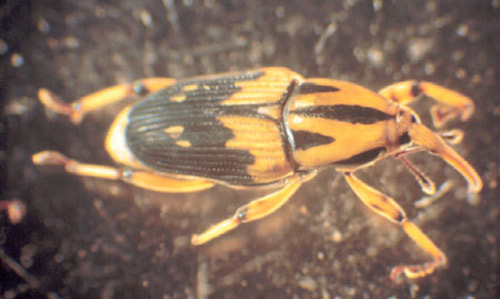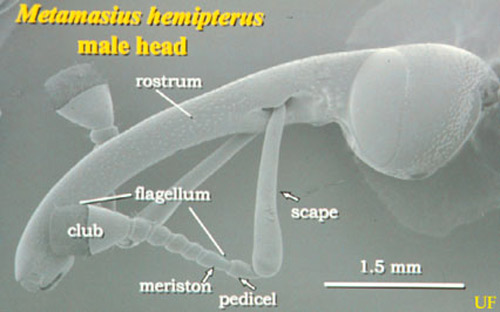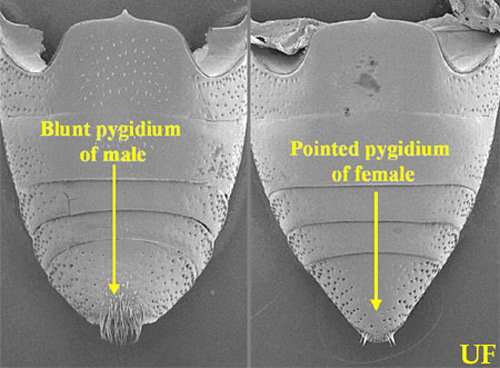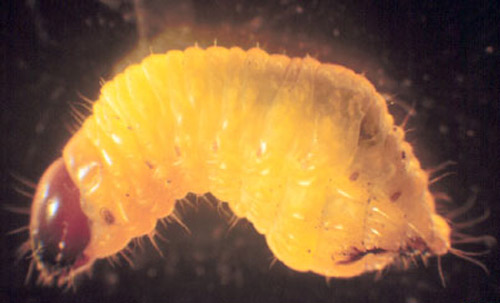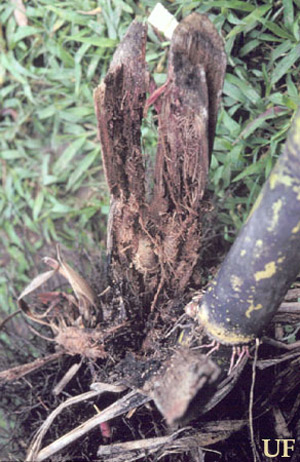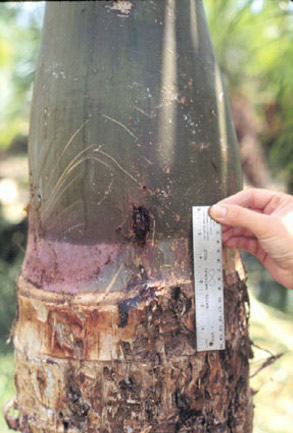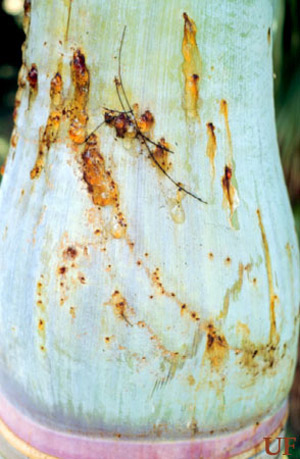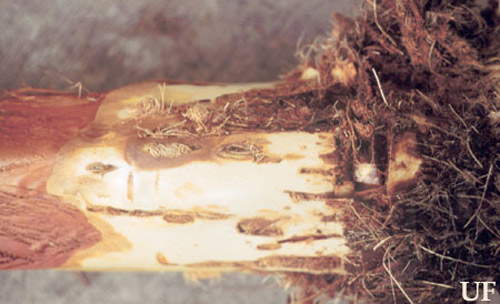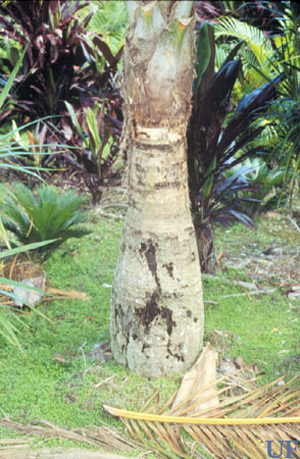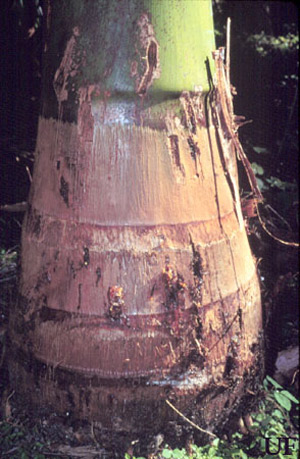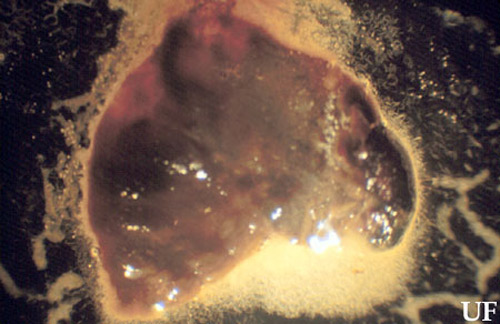common name: silky cane weevil
scientific name: Metamasius hemipterus sericeus (Olivier) (Insecta: Coleoptera: Curculionidae)
Introduction - Description - Life Cycle - Host Range - Damage - Dynamics and Trapping - Management - Selected References
Introduction (Back to Top)
The silky cane weevil (Metamasius hemipterus sericeus) is distributed through the West Indies, Central, and South America (Vaurie 1966), and was first reported in Dade County, Florida in 1984 (Woodruff and Baranowski 1985). In Florida, Metamasius hemipterus sericeus is an economically important pest of sugarcane, palms and other tropical plants. Larvae of Metamasius hemipterus sericeus are borers that tunnel through plant stems and petioles causing extensive damage.
Figure 1. Color pattern of the adult silky cane weevil, Metamasius hemipterus sericeus (Olivier). Photograph by Robin M. Giblin-Davis, Entomology and Nematology Department, University of Florida.
It was first discovered infesting sugarcane in the Belle Glade, Florida, area by Giblin-Davis et al. (1994) and a heavy infestation was observed by Sosa (1995) about 7 km south of South Bay, FL. A survey conducted by the Florida Sugarcane League and the USDA-ARS indicated that Metamasius hemipterus sericeus was widely distributed throughout the sugarcane production areas of Florida planted to cultivar 'CP-85-1382'. Metamasius hemipterus sericeus is generally considered a secondary pest of sugarcane and is attracted to stems damaged by mechanical cultivation, harvesting equipment, rats, other borers, disease, or natural growth cracks. Adults of Metamasius hemipterus sericeus are most numerous in the spring when they are attracted to a variety of decomposing crops post-harvest, field margins, or in cull piles. There are no labeled insecticides for Metamasius hemipterus sericeus in sugarcane in Florida. Cultural control focuses on the use of cultivars that do not form cracks at their bases. However, many newer cultivars being released for other issues, such as orange-rust resistance, can be prone to cracking, thereby making them very susceptible to Metamasius hemipterus sericeus (Gregg Nuessly, pers. comm.).
In addition to sugarcane, Metamasius hemipterus sericeus is also an important pest of nursery palms and banana plantings in South Florida as well as the West Indies and Central and South America. Larval tunneling through the stem, petioles and leaves of palms usually results in production of a gummy, amber-colored exudate (Giblin-Davis et al. 1996a). Infestations can often go undetected in trees such as Canary Island date palm causing an increase in weevil population. Host palm damage can be severe in some instances but infestations are rarely lethal. Ornamental crop production represents a 190 million dollar industry in South Florida. Losses in palm nursery production due to weevils, including damage by Metamasius hemipterus sericeus, Rhynchophorus cruentatus and Diaprepes abbreviatus, are high and contribute to a sizable portion of total pest control costs.
Description (Back to Top)
Adults of Metamasius hemipterus sericeus vary in color from red to orange and black. In addition, the pattern of coloration on the elytra, pronotum and venter is also variable. The femora are typically red, or red with black patterning. Total length of adults from the tip of the rostrum to the end of the pygidium varies from 9 to 14 mm. Larvae are legless grubs, and are creamy to yellowish in color. Their prominent head is reddish-brown and very hard and they have a ventral posterior protuberance.
Figure 2. SEM of head of adult male silky cane weevil, Metamasius hemipterus sericeus (Olivier). Photograph by Robin M. Giblin-Davis, Entomology and Nematology Department, University of Florida.
Figure 3. SEM comparison, ventral view of male and female pygidium, of the silky cane weevil, Metamasius hemipterus sericeus (Olivier). Photograph by Robin M. Giblin-Davis, Entomology and Nematology Department, University of Florida.
Figure 4. Larva of the silky cane weevil, Metamasius hemipterus sericeus (Olivier). Photograph by Robin M. Giblin-Davis, Entomology and Nematology Department, University of Florida.
Life Cycle (Back to Top)
Metamasius hemipterus sericeus has a complete life cycle: with an egg, several larval instars, pupal, and adult stages. Adults can live for 60 days and females deposit an average of 500 eggs (Castrillon and Herrera 1980). Females are attracted to and oviposit in damaged or stressed sugarcane stalks, banana pseudostems, ripe fruit (pineapple, mango, papaya), or palm sheaths or stems (Giblin-Davis et al. 1994). Eggs hatch in about four days and begin to feed. In sugarcane, larvae feed in the pith, sometimes boring into healthy tissue. Larval tunneling in palm starts in the petioles, wounds in petioles, crown, or stem and then extends into healthy leaf or stem tissue. After about seven weeks, larvae construct a fibrous pupal case similar to that constructed by Rhynchophorus cruentatus (Woodruff and Baranowski 1985). After about 10 days, pupae transform to adults which may immediately break free of the cocoon, or may remain within the cocoon until conditions are favorable for emergence (Woodruff and Baranowski 1985).
The adult stage of Metamasius hemipterus sericeus is free living, and often found on or within banana pseudostems, palm fronds, sugarcane sheaths, and leaf litter.
Host Range (Back to Top)
Metamasius hemipterus sericeus primarily infests banana and plantain, Musa spp., and interspecific hybrids of sugarcane. Infestations have also been observed in several ornamental palms such as Canary Island date palm, Phoenix canariensis; MacArthur palm, Ptychosperma macarthurii; majesty palm, Ravenia rivularis; royal palm, Roystonia regia; spindle palm, Hyophorbe verschaffeltii; and Washington fan palm, Washingtonia robusta (Giblin-Davis et al. 1994, Peña et al. 1995, Vaurie 1966).
Damage (Back to Top)
Metamasius hemipterus sericeus is generally considered to be a secondary pest of damaged sugarcane. However, larvae feeding on dead tissue often bore into and feed on healthy material resulting in significant damage or even cane death. Currently, Metamasius hemipterus sericeus in Florida infests 8 to 32% of the 'CP-85-1382' stalks under cultivation. Estimated losses in sugarcane production due to Metamasius hemipterus sericeus in Florida have run as high as $402.40/ha, or almost $6 million industry-wide (Sosa et al. 1997). Larval tunneling in palm starts in the petioles, wounds in petioles, crown, or stem and then extends into healthy leaf or stem tissue. Affected palms are often characterized by the production of an amber-colored and gummy exudate in the stem, crown shaft or petioles, and galleries in the leaves, petioles and stems (Giblin-Davis et al. 1994). Typically, Metamasius hemipterus sericeus infestations in palms are not lethal. However, aesthetic problems are observed such as exudate running down the palm stem or crown shaft. In addition, palm stress created by Metamasius hemipterus sericeus infestation can increase the chances of infestation by the palmetto weevil, Rhynchophorus cruentatus. Palmetto weevil infestations can be lethal to palms such as Phoenix canariensis. Because Metamasius hemipterus sericeus is a borer, it can be easily moved within plants and is considered to be a regulatory problem.
Figure 5. Damage to sugarcane by the silky cane weevil, Metamasius hemipterus sericeus (Olivier). Photograph by Robin M. Giblin-Davis, Entomology and Nematology Department, University of Florida.
Figure 6. Damage to spindle palm by the silky cane weevil, Metamasius hemipterus sericeus (Olivier). Photograph by Robin M. Giblin-Davis, Entomology and Nematology Department, University of Florida.
Figure 7. Closeup of damage to spindle palm by the silky cane weevil, Metamasius hemipterus sericeus (Olivier). Photograph by Robin M. Giblin-Davis, Entomology and Nematology Department, University of Florida.
Figure 8. Damage to Canary Island date palm by the silky cane weevil, Metamasius hemipterus sericeus (Olivier). Photograph by Robin M. Giblin-Davis, Entomology and Nematology Department, University of Florida.
Figure 9. Damage to majesty palm by the silky cane weevil, Metamasius hemipterus sericeus (Olivier). Photograph by Robin M. Giblin-Davis, Entomology and Nematology Department, University of Florida.
Figure 10. Damage to royal palm by the silky cane weevil, Metamasius hemipterus sericeus (Olivier). Photograph by Robin M. Giblin-Davis, Entomology and Nematology Department, University of Florida.
Dynamics and Trapping (Back to Top)
Population assessment of Metamasius hemipterus sericeus is problematic. Trapping of adults is the method most often used to monitor weevil populations. Vilardebo (1973) and later Castrillon and Herrera (1980) suggested the use of a "sandwich trap" using banana pseudostem as an attractant. Using the same trapping method, Peña et al. (1995) determined that populations build up during the spring, summer and early fall in Florida, but warned that the number of weevils collected at these traps was consistently low. Perez et al. (1997) have identified major male-produced aggregation pheromones and host kairomone compounds while Giblin-Davis et al. (1996b) have optimized trap designs and protocols that can be used for enhanced monitoring of weevil populations in the field. In addition, Alpizar et al. (2002) have demonstrated that pheromone and host-baited traps can be used to mass trap Metamasius hemipterus sericeus infesting palmito palms in Costa Rica.
Management (Back to Top)
Chemical Control. Chemically-based management tactics are currently recommended for control of Metamasius hemipterus sericeus. Giblin-Davis et al. (1996a) demonstrated that adults of Metamasius hemipterus sericeus were killed by labeled rates of acephate, carbofuran, chlorpyrifos, cyfluthrin, disulfoton, imidacloprid, isofenphos, lindane and vydate.
Florida Landscape Plant Insect Management Suggestions
Entomopathogens. The use of entomopathogens provides a promising means of managing Metamasius hemipterus sericeus. The entomogenous fungi, Beauveria bassiana (Balsamo) Vuillemin and Metarhizium anisopliae (Metchnikoff) Sorokin, have gained considerable attention as potential control agents for weevils (Mesquita et al. 1981, Peña et al. 1995, Giblin-Davis et al. 1996a). Giblin-Davis et al. (1996a) demonstrated that the nematode Steinernema carpocapsae was efficacious against larvae but not the adults of Metamasius hemipterus sericeus. Researchers have concluded that because of the potential for high weevil production per Canary Island date palm in Florida and the cryptic habitat of the boring stages of this weevil, chemical insecticides and entomopathogenic nematodes would need to be applied frequently and over a long period of time for effective management of established populations.
Figure 11. Nematode infested larva of the silky cane weevil, Metamasius hemipterus sericeus (Olivier). Photograph by Robin M. Giblin-Davis, Entomology and Nematology Department, University of Florida.
Biological Control. Biological control is expected to provide additional, possibly more effective, management of Metamasius hemipterus sericeus in Florida and the Caribbean. However, very little is known about effective biocontrol agents of Metamasius hemipterus sericeus in the Americas and the Caribbean. Siqueira et al. (1996) identified predators of Metamasius at the family level and stated that they were more abundant in Brazil than were parasitoids. These predatory insect families included Labiduridae, Histeridae, Staphylinidae, Carabidae, Cicindelidae, Formicidae and Reduviidae. A parasitoid was observed and identified as a tachinid.
Selected References (Back to Top)
- Alpizar D, Fallas M, Oehlschlager AC, Gonzalez LM, Chincilla CM, Bulgarelli J. 2002. Pheromone mass trapping of the West Indian sugarcane weevil and the American palm weevil (Coleoptera: Curculionidae) in palmito palm. Florida Entomologist 83: 426-430.
- Castrillon C, Herrera JG. 1980. Los picudos negro y rayado del platano y banano. Ica-Informa, Separata, 4 pp.
- Giblin-Davis RM, Peña JE, Duncan RE. 1994. Lethal pitfall trap for evaluation of semiochemical mediated attraction of Metamasius hemipterus sericeus (Coleoptera: Curculionidae). Florida Entomologist 77: 247-255.
- Giblin-Davis RM, Peña JE, Duncan R. 1996a. Evaluation of entomogenous nematodes and chemical insecticides for control of Metamasius hemipterus sericeus (Olivier) (Coleoptera:Curculionidae). Journal of Entomological Science 31: 240-251.
- Giblin-Davis RM, Peña JE, Oehlschlager AC, Perez AL. 1996b. Optimization of Semiochemical-based trapping of Metamasius hemipterus sericeus (Olivier) (Coleoptera:Curculionidae). Journal of Chemical Ecology 22: 1389-1410.
- Mesquita ALM, Lucchini F, Alves EJ, Caldas RC. 1981. Influencia dos fatores ambiental no grau de parasitismo de Beauveria bassiana sobre Cosmopolites sordidus e Metamasius hemipterus, em cultivo da bananeira. Pesquisa em andamento - EMBRAPA, Centro Nacional de Pesquisa de Mandioca e Fruticultura., no. 14, Aug 1981.
- Peña JE, Giblin-Davis RM, Duncan R. 1995. Impact of indigenous Beauveria bassiana (Balsamo) Vuillemin on banana weevil and rotten sugarcane weevil (Coleoptera: Curculionidae) populations in banana in Florida. Journal of Agricultural Entomology 12: 163-167.
- Perez AL, Campos Y, Chinchilla CM, Oehlschlager AC, Gries G, Gries R, Giblin-Davis RM, Castrillo G, Peña JE, Duncan RE, Gonzalez LM, Pierce HD Jr, McDonald R, Andrade R. 1997. Aggregation pheromones and host kairomones of West Indian Sugarcane Weevil, Metamasius hemipterus sericeus. Journal of Chemical Ecology 23: 869-888.
- Siqueira HA, Barreto R, Cavalcante T, Picanco M. 1996. Controle biologico de Cosmopolitus sordidus e Metamasius sp. (Coleoptera: Curculionidae) em bananeoira por predadores e parasitoides. V Siconbiol, Foz de Iguaçu, Brazil, 9-14 June, p. 161.
- Sosa O. 1995. The West Indian cane weevil and the sugarcane rootstalk borer weevil-likely pests of sugarcane in Florida. Sugar Journal 58: 27-29.
- Sosa O, Shine J, Tai P. 1997. West Indian cane weevil (Coleoptera: Curculionidae): a new pest of sugarcane in Florida. Journal of Economic Entomology 90: 634-638.
- Woodruff RE, Baranowski RM. 1985. Metamasius hemipterus (Linnaeus) recently established in Florida (Coleoptera: Curculionidae). Florida Department of Agriculture and Consumer Services Division of Plant Industry, Entomology Circular 272. 4 pp.
- Vaurie P. 1966. A revision of the Neotropical genus Metamasius (Coleoptera: Curculionidae, Rhynchophorinae). Species groups I and II. Bulletin of the American Museum of Natural History 131: 213-337.
- Vilardebo A. 1973. Le coefficient d'infestation, critère d'evaluation du degré d'attaques des bananerais par Cosmopolites sordidus Ger., le charançon noir du bananier. Fruits 28: 417-426.
